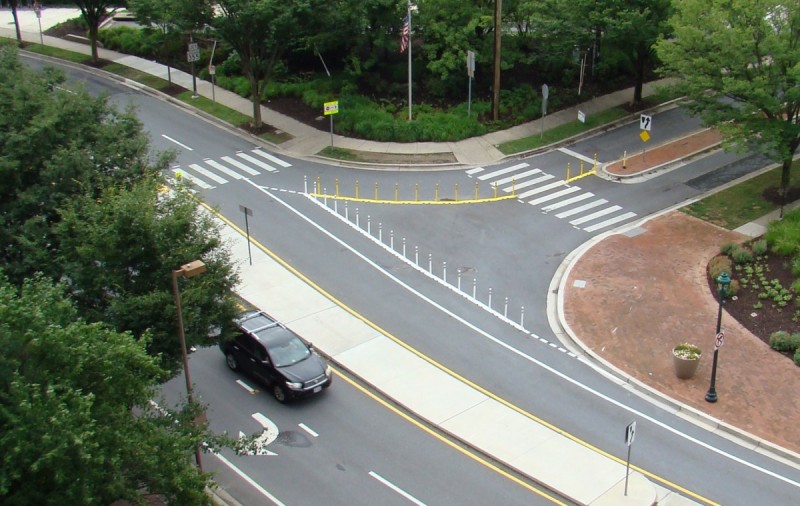Neighbors get a road blocked in Bethesda, but it hurts everyone else

Image by Ben Ross.
Near downtown Bethesda is a residential street, Leland Street. Some people drove on that street to get to and from the business district. Neighbors complained, so the county added a barricade. Many of our contributors think doing this kind of thing for one street sets a really bad precedent.
In this case, the divider prevents turning right from Woodmont Avenue, a main street of downtown Bethesda, onto Leland Street heading away from Bethesda. A divider on Woodmont already prevents turning from Leland onto Woodmont going toward Bethesda.
An existing restriction, enforced with signs but not very often in another way, forbade the Woodmont to Leland right turn weekday afternoons from 4 to 7 pm. According to Andrew Metcalf at Bethesda Magazine, the county DOT made this change on its own and the County Council was not involved.
Our contributors discussed the issue via email. Dan Reed said,
[This] is very common, not just in Montgomery County, but all over the region. Neighbors worry about cut-through traffic and parking near Metro stations and (in MoCo) at least the county makes it very easy for them to petition to have a street closed. I think people often get sympathy because nobody likes speeding drivers or cut-through traffic on their street, but this only dumps the traffic onto main roads, which makes them worse places to live or walk or bike (or, frankly, to drive on).
David Cranor added,
There is no such thing as cut-through traffic. There is just traffic. People going someplace from someplace else—on roads—which is what they are for.
If they say traffic is too fast and want to put in traffic calming, I absolutely support that. Camera it up and narrow it down. Slow the speed limit to 15 mph if that's what it takes. But the idea that there are just too many cars—I mean, I'm sorry, but I just don't care. That's what roads are for.
Image by Google Street View.
Ben Ross explained that Leland Street already had gotten other measures to calm the traffic, such as pedestrian islands which force cars to slow down. And, he said, “It's worth noting that this street has permit parking, and the permit parking district is carefully gerrymandered so that none of the apartments that surround it on all sides are included.”
Tracy Johnstone thinks the change isn't so bad. She said, “As a pedestrian, crossing Leland—especially at night—was very dangerous as cars turning right onto Leland ignored the 'no right turn' during restricted hours and MCPD would enforce the rule only once a year.”
David Cranor suggested a better solution:
A better option for making it safer for pedestrians would be reshaping that west corner of Woodmont and Leland. It's built with a very generous curve that invites turning too fast. Sharpen that up to more of a square corner and it will force drivers to slow down, while also shortening crossing distances.
David's suggestion sounds good to me! I'd add that at some times in the past and in some places, the streets are/were much less busy. We could design communities that involve less driving, but that would require more transit, walking, and bicycling facilities, devoting less road space to cars and parking, and allowing denser housing so more people can live near their jobs.
These are policies that Montgomery County flirts with but is still often reluctant to embrace. Forbidding driving one one connecting road to satisfy some residents while making traffic worse for everyone else is not the best approach, here or anywhere else in the region.
